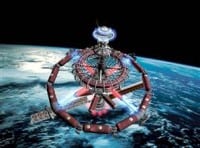PARIS HILTON OPENS THE STELLA FOR CHRISTMAS

Welcome to the hotel at 'the edge of the world'
- Dateline
- 22 December 2017
The Stella Hilton officially opened for guests in time for the Christmas holidays. The glittering ‘first night’ featured Senator Charlize Theron and veteran space tourist Mark Shuttleworth.
The low-gravity welcoming committee presided over by Paris Hilton (in a scanty silver space-wrap) included Richard Branson and a remarkably life-like android of Douglas Adams.
Funded entirely by private enterprise and situated 242 km above the Earth, the Stella is only just beyond our atmosphere, but offers a space station experience on the threshold of the universe beyond our planet’s orbit.
The Stella is a hub-and-wheel design, spinning gently to provide the convenience of low but useful ‘gravity’ in the lounges and rooms on the rim. In the center are the Zero-G Experience deck and the Galaxy honeymoon suite, with a surround view of the Milky Way guaranteed to turn a newlywed’s head – several times!
As may be expected, the hotel is already fully booked well into the New Year. Guests seem only too happy to fork out the $10,000 per night and $75,000 fare on Virgin Galactic or SpaceX, despite having to undergo a three-day aerospace travel certification course.
After welcoming the arrivals, Paris Hilton was last seen entering the Zero-G zone with Mark Shuttleworth…
ANALYSIS >> SYNTHESIS: How this scenario came to be
“It’s only a question of time and money,” Howard Wolff, senior vice president of the international architecture and design firm Wimberly Allison Tong & Goo, explains from his office in Honolulu. “The obstacle is not technology. The Catch-22 is that a space hotel won’t be affordable until there is a mass market for space tourism … and there won’t be a mass market until it’s affordable.”
The missing ingredient is a commercially viable fleet of reusable launch vehicles. “You can’t have a successful hotel if you don’t have the means of getting people there.” (from Space.com)
In 2002 Mark Shuttleworth visits the International Space Station (ISS) aboard the Russian Soyuz. At a cost of US$ 20 million it’s hardly an affordable trip. Russia offers the first honeymoon in space on the ISS for US$ 42 million. There are no takers.
NASA lands a second and third robot vehicle on Mars at a total cost of US$ 820 million but dithers over a replacement for the Shuttle. President Bush announces 20-year plans to send manned flights to the Moon and Mars, and calls for partners. SpaceX leads the charge from private enterprise, with many running mates, funded mainly by Internet billionaires like Elon Musk.
In 2004 Burt Rutan’s SpaceShipOne wins the X Prize with two trips into space in six days. The sub-orbital space plane is beyond the limit of the earth’s atmosphere for less than three minutes, but the point is made: the entire development cost is only US$ 20 million.
Richard Branson immediately launches Virgin Galactic to offer scheduled ‘flights’ into space as soon as Scaled Composites can provide the planes.
In 2007 manned space flight by private enterprise gets underway in earnest. China becomes the largest manufacturer and exporter of space transport hardware. Russia’s proven but aging launch technology is overtaken by more economical alternatives, but not from NASA, whose Orbital Space Plane is dogged with teething problems and budget overruns. Virgin Galactic dominates the new craze of sub-orbital space flips, available from three different private operators. The ISS remains the only destination for orbital space tourists.
NASA bans further tourist trips to the ISS as ‘detrimental to operations’. A project to build a space station for tourists is launched by a consortium headed by Space Islands.
By 2014 sub-orbital flight matures, with planes carrying 12-20 passengers making daily trips. Hypersonic transatlantic and transcontinental flights take only 15 minutes, making the Concorde of yesteryear seem slow by comparison. SpaceX offers the cheapest route to orbit, servicing the ISS with its Falcon 5 rockets at a third of the price of the Russians.
Paris opens the Stella Hilton in time for Christmas 2017. It’s a little later than Arthur C Clarke would have liked – he’s been waiting since 2001!
“In ‘2001: A Space Odyssey’, Stanley Kubrick and I depicted a commercial spaceplane delivering passengers to a huge, wheel-shaped space station. Commercially operated hotels, restaurants and videophone booths were plentiful onboard. Stanley and I firmly believed that commercial stations would offer the citizens of Earth far greater access to space than government-run programs.”
How right he was.
Links to related stories
- Hilton to back space hotel - BBC News 9 March 1999
- Space Hotels - spacefuture.com
- The X Prize Foundation
- Boeing Launches Orbital Space Plane Design - Boeing press release
- Launch could lead to new age of tourism: Company's first venture is part of a plan to make space travel cheaper for paying passengers - Houston Chronicle 25 November 2005
- Rocket damage puts a dent in SpaceX plans - MSNBC 19 December 2005
Warning: Hazardous thinking at work
Despite appearances to the contrary, Futureworld cannot and does not predict the future. Our Mindbullets scenarios are fictitious and designed purely to explore possible futures, challenge and stimulate strategic thinking. Use these at your own risk. Any reference to actual people, entities or events is entirely allegorical. Copyright Futureworld International Limited. Reproduction or distribution permitted only with recognition of Copyright and the inclusion of this disclaimer.